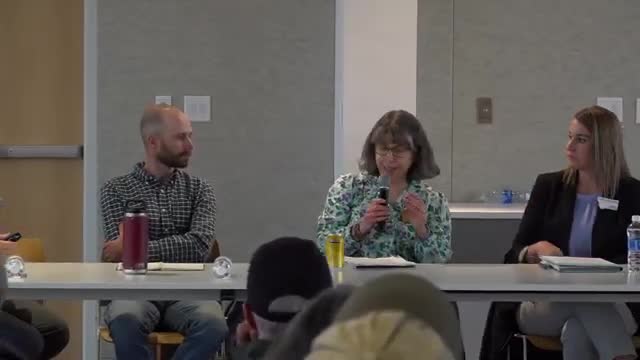DNRC and partners push pilot storage, gauge expansion and mitigation options as flows shift
November 10, 2025 | Missoula, Missoula County, Montana
This article was created by AI summarizing key points discussed. AI makes mistakes, so for full details and context, please refer to the video of the full meeting. Please report any errors so we can fix them. Report an error »

Missoula — Valerie Kurth, Clark Fork Basin Water Planner with the Montana Department of Natural Resources and Conservation, described DNRC’s multi‑pronged approach to drought and flood resilience: improved hydrologic data, statewide modeling, and pilot storage grants that include managed aquifer recharge and soil‑storage tactics.
Monitoring and modeling: Kurth said DNRC is expanding both data collection and tools. "We are also proud to be collaborating with the Clark Fork Coalition on a hydrologic data project in the Upper Clark Fork," she said, and noted recent funding to expand the state stream gauge network toward a goal of 100 real‑time gauges across Montana.
Storage and mitigation: Kurth added that the state’s upcoming pilot storage grant program is intended to test a range of approaches — below‑ground recharge, aquifer storage and recovery, and working with irrigators to store water in soils for later use. She and panelists identified mitigation water — securing legally allowable water to offset new appropriations in over‑appropriated basins — as a legislative and administrative focus, but cautioned the earlier bill efforts failed because mitigation alternatives were not viable everywhere.
Exempt wells and enforcement limits: Kurth acknowledged DNRC’s limited enforcement capacity on exempt wells and said the agency must prioritize site‑specific studies and mitigation solutions. "DNRC just doesn't have the capacity in our regional offices to monitor all of that," she said, noting enforcement challenges and the need to develop mitigation options that are available to affected basins.
Tribal and local roles: Tribal restoration and land purchases to reconnect floodplain (Chris Stark) and local pilot projects were described as important complements to state planning. Panelists urged coordination among tribes, state agencies, nonprofits and landowners to find workable storage and mitigation strategies.
Next steps: DNRC will continue to design pilot criteria, expand hydrologic monitoring and work with partners on mitigation water availability; stakeholders said community input and technical advisory groups remain vital.
Monitoring and modeling: Kurth said DNRC is expanding both data collection and tools. "We are also proud to be collaborating with the Clark Fork Coalition on a hydrologic data project in the Upper Clark Fork," she said, and noted recent funding to expand the state stream gauge network toward a goal of 100 real‑time gauges across Montana.
Storage and mitigation: Kurth added that the state’s upcoming pilot storage grant program is intended to test a range of approaches — below‑ground recharge, aquifer storage and recovery, and working with irrigators to store water in soils for later use. She and panelists identified mitigation water — securing legally allowable water to offset new appropriations in over‑appropriated basins — as a legislative and administrative focus, but cautioned the earlier bill efforts failed because mitigation alternatives were not viable everywhere.
Exempt wells and enforcement limits: Kurth acknowledged DNRC’s limited enforcement capacity on exempt wells and said the agency must prioritize site‑specific studies and mitigation solutions. "DNRC just doesn't have the capacity in our regional offices to monitor all of that," she said, noting enforcement challenges and the need to develop mitigation options that are available to affected basins.
Tribal and local roles: Tribal restoration and land purchases to reconnect floodplain (Chris Stark) and local pilot projects were described as important complements to state planning. Panelists urged coordination among tribes, state agencies, nonprofits and landowners to find workable storage and mitigation strategies.
Next steps: DNRC will continue to design pilot criteria, expand hydrologic monitoring and work with partners on mitigation water availability; stakeholders said community input and technical advisory groups remain vital.
View full meeting
This article is based on a recent meeting—watch the full video and explore the complete transcript for deeper insights into the discussion.
View full meeting
